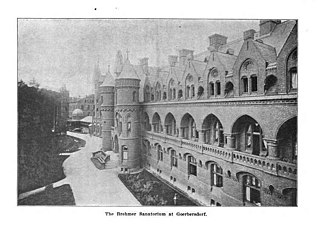
Walker is a city in Cass County, Minnesota, United States. The population was 966 at the 2020 census. It is the county seat of Cass County.

A sanatorium, also sanitarium or sanitorium, is a historic name for a specialised hospital for the treatment of specific diseases, related ailments, and convalescence. Sanatoriums are often in a healthy climate, usually in the countryside. The idea of healing was an important reason for the historical wave of establishments of sanatoria, especially at the end of the 19th and early 20th centuries. One sought, for instance, the healing of consumptives especially tuberculosis or alcoholism, but also of more obscure addictions and longings of hysteria, masturbation, fatigue and emotional exhaustion. Facility operators were often charitable associations, such as the Order of St. John and the newly founded social welfare insurance companies.

The Waverly Hills Sanatorium is a former sanatorium located in the Waverly Hills neighborhood of Louisville, Kentucky.

The Leech Lake Reservation is an Indian reservation located in the north-central Minnesota counties of Cass, Itasca, Beltrami, and Hubbard. The reservation forms the land base for the federally recognized Leech Lake Band of Ojibwe, one of six bands comprising the Minnesota Chippewa Tribe, organized in 1934. The Leech Lake Reservation has the second highest population of any reservation in Minnesota with White Earth Nation being the largest Minnesota Ojibwe tribe, Leech Lake Nation has a resident population of 11,388 indicated by the 2020 census.

Royal Brompton Hospital is the largest specialist heart and lung medical centre in the United Kingdom. It is managed by Guy's and St Thomas' NHS Foundation Trust.

City of Hope is a private, non-profit clinical research center, hospital and graduate school located in Duarte, California, United States. The center's main campus resides on 110 acres (45 ha) of land adjacent to the boundaries of Duarte and Irwindale, with a network of clinical practice locations throughout Southern California, satellite offices in Monrovia and Irwindale, and regional fundraising offices throughout the United States.

Glen Lake Children's Camp is a former children's camp for victims of tuberculosis. The camp was part of the Glen Lake Sanatorium on the border of Minnetonka and Eden Prairie, Minnesota. Although the main sanatorium buildings were demolished in 1993, the children's camp portion remained intact. The camp is Minnesota's only known surviving camp for children who had tuberculosis, and it reflects the philanthropic efforts of its founders, George H. and Leonora Christian. It was listed on the National Register of Historic Places on August 5, 1999.

The Boston Sanatorium is a historic tuberculosis hospital in the Mattapan neighborhood of Boston, Massachusetts. It consists of a complex of eighteen historic buildings on 52 acres (21 ha) of land. Most of these buildings were built between 1908 and 1932, although the Superintendent's House predates the hospital's construction; it is an Italianate house built c. 1856. They are predominantly brick buildings that are Colonial Revival in character, although the 1929 main administration building has a variety of different revival elements. Several of the buildings on the campus—The Administrative or Foley Building; The Doctor's Residences, Dormitories and Wards; and The Power House—were designed by the renowned architectural firm Maginnis and Walsh. The complex was the largest tuberculosis hospital in the state, built in response to reports that the disease was responsible for more deaths than any other in the city. The facility was used for the treatment of tuberculosis through the middle of the 20th century, and then stood largely vacant until 2002, when plans were laid to rehabilitate the property for other uses.

Glen Lake Sanatorium, a tuberculosis treatment center serving Hennepin County in Minnesota, opened on January 4, 1916, with a capacity of 50 patients, and closed in 1976. In 1909, the Minnesota State Legislature had passed a bill authorizing the appointment of county sanatorium boards and appropriating money for the construction of county sanatoriums. Glen Lake Sanatorium was the fifth of fourteen county sanatoria that opened in Minnesota between 1912 and 1918. Glen Lake was the first U.S. tuberculosis sanatorium to be accredited by the American Medical Association.The sanatorium had its own post office, and the mailing address was Glen Lake Sanatorium, Oak Terrace, Minnesota, until the surrounding area was incorporated into the City of Minnetonka.

This is a list of the National Register of Historic Places listings in Cass County, Minnesota. It is intended to be a complete list of the properties and districts on the National Register of Historic Places in Cass County, Minnesota, United States. The locations of National Register properties and districts for which the latitude and longitude coordinates are included below, may be seen in an online map.
Ah-gwah-ching is an unincorporated community in Shingobee Township, Cass County, Minnesota, United States, near Walker.

The Seaside is a historic medical facility at 36 Shore Road in Waterford, Connecticut. It is nationally significant as the first institution designed for heliotropic treatment of children suffering from tuberculosis. Its buildings "comprise an exceptional collection of fully realized and generally well-preserved Tudor Revival-style institutional architecture", which were designed by Cass Gilbert. The property was listed on the National Register of Historic Places in 1995.

Lesnoye Sanatorium is the oldest medical institution in the city of Tolyatti, Russia. Its main focus is tuberculosis treatment.
The Rutland Heights State Hospital was a state sanatorium for the treatment of pulmonary tuberculosis located in Rutland, Massachusetts, built for the purpose of treating Tuberculosis patients. The facility was the first state-operated sanatorium in the United States, opening in 1898 and operating for around 93 years before its closure in 1991. Rutland Heights opened under the title “Massachusetts Hospital for Consumptives and Tubercular Patients,” to which it operated until 1900, where it was renamed to “Massachusetts State Sanatorium.” In 1919 it was renamed to “Rutland State Sanatorium,” which was the longest operating name of the hospital, effective until 1963. In 1963, it was renamed briefly to “Rutland Hospital,” and successively in 1965 to “Rutland Heights State Hospital,” which was the final title of the hospital until closing. In 2004, the hospital was demolished.
Government Hospital of Thoracic Medicine, popularly known as the Tambaram TB Sanatorium, is a major state-owned hospital situated in Chennai, India. The hospital is funded and managed by the state government of Tamil Nadu. It was founded in 1928.
The town of Colorado Springs, Colorado, played an important role in the history of tuberculosis in the era before antituberculosis drugs and vaccines. Tuberculosis management before this era was difficult and often of limited effect. In the 19th century, a movement for tuberculosis treatment in hospital-like facilities called sanatoriums became prominent, especially in Europe and North America. Thus people sought tuberculosis treatment in Colorado Springs because of its dry climate and fresh mountain air. Some people stayed in boarding houses, while others sought the hospital-like facilities of sanatoriums. In the 1880s and 1890s, it is estimated that one-third of the people living in Colorado Springs had tuberculosis. The number of sanatoriums and hospitals increased into the twentieth century. During World War II, medicines were developed that successfully treated tuberculosis and by the late 1940s specialized tuberculosis treatment facilities were no longer needed.

Ethan Allen School for Boys was a reform school in Delafield Town, Wisconsin which operated in a former tuberculosis sanitorium from April 1959 until June 2011, when it was abolished and the inmates moved to Lincoln Hills School in Irma. It was operated by the Wisconsin Department of Corrections.

The Firland Sanatorium was Seattle's municipal tuberculosis treatment center. It opened on May 2, 1911, and closed on October 30, 1973.

Samuel H. Golter was born in Russia but emigrated to the United States in 1906. In 1926, he became superintendent of the Los Angeles Sanatorium, a free treatment center run by the Jewish Consumptive Relief Association in Duarte, California. In 1932, Golter became Executive Director. He led a nationwide campaign to eliminate the institution's large debt, followed by a successful expansion. Under his leadership, the institution transitioned from a small tuberculosis treatment center to a major research, teaching, and treatment center for cancer and other diseases, with a $600,000 annual budget. Long nicknamed "The City of Hope", the expanded institution was officially renamed the City of Hope National Medical Center.

The Jewish Consumptives' Relief Society (JCRS) was a non-sectarian sanatorium to treat tuberculosis patients in Lakewood, Colorado. Founded in 1904, the sanatorium campus was also home to the first synagogue in Jefferson County, Colorado. In 1954 the institution changed its mission to cancer research and became The American Medical Center at Denver. The American Medical Center merged with the University of Colorado Anschutz Medical Campus in 2002.




















